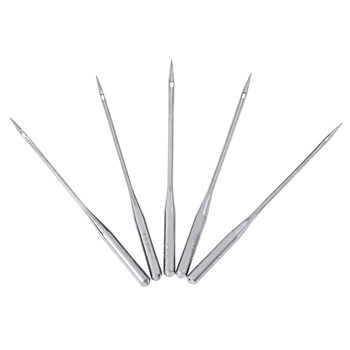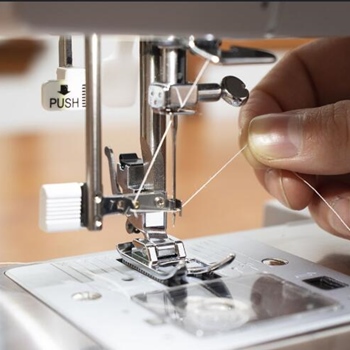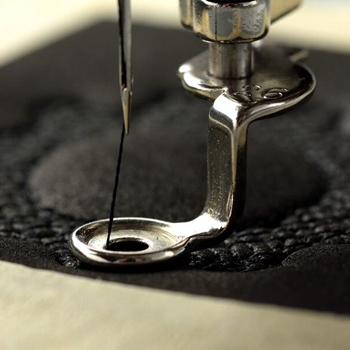Many manufacturers make sewing machine needles. It’s not easy making your pick between Inspra, Singer, Klasse, Schmetz, and Organ (and there are so many more out there!). It can be especially intimidating to novice seamstresses.
Let me tell you right away – all of these brands are good, and all have their strengths and weaknesses. Personally, I use either Singer or Schmetz, but that’s mainly because these brands are sold at my local sewing supplies shop.
What really matters is that you choose the correct needle type for your project. That’s not always easy and straightforward – and that’s exactly why I decided to make this guide to identifying sewing machine needles.
Sewing Machine Needle Sizes
 You’re probably familiar with this rule: the thinner the fabric, the thinner the needle (and vice versa). Following this simple idea with basic, universal needles is sufficient for 90% of regular sewing tasks, especially for beginners. So, how do we express needle size in numbers, and what fabrics do these correspond to?
You’re probably familiar with this rule: the thinner the fabric, the thinner the needle (and vice versa). Following this simple idea with basic, universal needles is sufficient for 90% of regular sewing tasks, especially for beginners. So, how do we express needle size in numbers, and what fabrics do these correspond to?
Essentially, on every needle, you can see two numbers. The two numbers show the same thing, but it’s expressed in both American and European size measurements. The numbers refer to the thickness of the needle – all sewing machine needles are more or less the same length.
The European numbers come first, and they’re labeled in numbers 60 to 120. The corresponding American sizes are labeled in numbers between 8 and 20. The lower the number, the thinner the needle. The actual labeling on a sewing machine needle pack looks like, for example, 65/9, or 110/18.
Needle Size and Fabric Weight
Using the right size is important. If your needle is too big for your fabric, you’ll be left with unsightly holes and a higher chance of tearing. On the other hand, a needle too small will likely break or bend if you try to use it on a heavier weight fabric, and a flying needle tip can be quite dangerous.
- If you want to use very fine fabrics like chiffon, organza, fine silk, or lace, you should choose the finest needles available. These include sizes 60/8, 65/9, and 70/10.
- For regular lightweight fabrics, use 75/11 and 80/12 needle sizes. These include fabrics like cotton voile, silk, spandex, and lycra.
- 90/14 is the medium size needle that’s fit for many fabrics out there. These medium-weights include most quilting fabrics (use a quilting needle for these projects!), cotton, linen, muslin, jersey, light wool, light corduroy, and light velvet, many types of knit fabrics, tricot, and fleece.
- Heavier weight fabrics like denim, canvas, corduroy, suiting, and duck require a thicker needle, and the ideal thickness for these fabrics is 100/16.
- Extra-heavy fabrics should be approached with either a 110/18 or a 120/20 needle, and these include heavy denim and canvases, furs (real or faux), and upholstery fabrics.
Types of Sewing Machine Needles
Sewing machine needles come in all sorts of shapes and sizes. But to discuss different needle types effectively, we need to nail down the anatomy of a sewing machine needle.
- The tip of the needle is sharp and it pierces the fabric.
- The eye of the needle is the little hole that the thread goes through.
- The body of the needle is called the shaft or the blade, and it’s the diameter of the shaft that determines needle size.
- The shank of the needle is the wider part that’s inserted into the needle holder in your machine, and the shank and the shaft are connected by a tapering part called the shoulder.
- Depending on the type, a needle can have a scarf, an indentation above the eye of the needle that helps the bobbin hook pass the needle seamlessly.
- Also, some needles have more and some less of a groove – an indentation that runs down the shaft, with the role to guide the thread and keep it protected from friction during stitching.
1. Universal
The universal needle has a slightly rounded point. As you can guess from the name, it can be used for many projects out there, though there is usually a better needle pick for that particular project. Woven of knit fabrics – it doesn’t matter, the universal needle can handle it all with fair-looking results.
2. Jersey Ball Point
Ballpoints rock a rounded tip. Rather than cut the fabric fibers, the jersey ballpoint pushes the fibers apart, letting the thread go through. That’s exactly why this type of needle is ideal for knit fabrics. From rib knits to double knit – use this needle to sew these sensitive, stretchy materials without causing damage. The fact it doesn’t damage fibers prevents fabric laddering and similar damage.
3. Stretch
 Stretchy fabrics are notorious for being difficult to work with. If you’re dealing with issues like skipped stitches, a stretch needle might be a great solution. The design of this needle features an indentation called the scarf which lets the bobbin hook pass the needle with ease. This type of medium ballpoint needle is usually used with stretchy fabrics like lycra, power mesh, silk jersey, and spandex.
Stretchy fabrics are notorious for being difficult to work with. If you’re dealing with issues like skipped stitches, a stretch needle might be a great solution. The design of this needle features an indentation called the scarf which lets the bobbin hook pass the needle with ease. This type of medium ballpoint needle is usually used with stretchy fabrics like lycra, power mesh, silk jersey, and spandex.
4. Microtex – Sharps
Microtex, otherwise known as Sharps needles, have a super sharp tip that pierces through any type of fabric. The shafts of these needles are strong, further supported by a short, round eye, which makes this needle exceptionally hard to bend and break. They’re used with all sorts of fabrics, but show a particularly great performance with projects with several layers of densely woven fabrics.
5. Quilting
The quilting needle also comes with an acute angle tip that’s great at cutting through several layers of fabric and wadding at once. While Microtex needles can be used for quilting sewing, the actual quilting needle is much shorter. This lets quilters create that unique quick and even stitch that quilts need. Experienced quilters may decide to work with longer and thicker needles, but beginners will most likely find it easier to work with a smaller size, thin quilting needle.
6. Jeans
If you’re working with a densely woven fabric like heavy twill, duck, canvas, linen, and yes – denim, your best bet is picking a jeans needle. These heavyweight fabrics can be quite tough on your needle (especially when there are several layers!), so a specialized, reinforced needle is a great pick. The jeans needle doesn’t only come with a stronger shaft, but it also has a specially designed blade on its modified medium ballpoint tip, which cuts through the fabric, letting the needle slide through with ease. This needle should be used with synthetic threads, especially heavyweight polyester thread.
7. Leather
Natural leather is unique among fabrics because it’s neither woven nor knit – in fact, it has no holes whatsoever as other fabrics do. That’s why a universal needle definitely won’t do, you need a special leather needle. This needle comes with a special chisel point (a blade) that’s designed to cut through the material.
8. Embroidery
Whenever you do decorative stitching, an embroidery needle can help make sure everything passes smoothly, without snapped thread. Embroidery sewing requires thicker thread, so embroidery needles rock a larger, wider eye to accommodate it. The needle has a light ballpoint and a groove, so it’s completely adjusted to this sort of thread. Another key feature of this needle is a pontoon scarf with a large bump, which reduces the fabric movement, preventing many problems during embroidering.
9. Topstitch
The topstitch needle is super sharp and features an eye that’s much larger than usual. The big eye both wider and longer than on other needle types, and it’s designed that way to accommodate the thicker threads used for some topstitching tasks. Additionally, the shaft of the needle has a deep groove that protects the thread from friction during stitching. The downside of topstitch needles is that the bigger eye makes it more likely the needle will break if something goes wrong.
10. Twin and Triple
The twin needle is exactly what it sounds like – two needles attached to a single holder. They’re often used for symmetrical decorative stitches and pin tucking because they let you make two or three rows of stitches at the time. Twin needles actually come in a variety of types (including jeans, embroidery, stretch, and universal), and sometimes, you can even choose the distance between the two needles. Triple needles are typically just the universal type.
Thread Weight Matters Too
 There are different ways to measure thread weight depending on where you are in the world. But here in the US, we use something called fixed weight measurement to label the thickness of the thread.
There are different ways to measure thread weight depending on where you are in the world. But here in the US, we use something called fixed weight measurement to label the thickness of the thread.
You should always keep in mind that thread weight labels work the other way round compared to needle sizes. Meaning: The lower the number, the thicker the thread.
That’s because thread weight is actually the relationship between the weight in grams and the length of thread in meters. So, if 1 gram’s worth of your thread covers 50 meters, you have a spool of 50 wt. thread. Therefore, threads with a higher wt. number are finer.
In real life, that means that you need a thread between 100 wt. and 60 wt. for fine needles like 60/8 or 65/9. For 90/14 medium needles, you should use medium thread at around 40 wt. Heavyweight fabrics and big needles require thick thread labeled with 30 wt. or a smaller number.
That’s It!
There you have it – all you need to know about sewing machine needles! I hope that you understood everything and that you’ll refer back to this blog post when choosing the ideal needle for your next project. If you have any questions left or you simply want to share some of your experience and wisdom regarding sewing machine needles and thread, don’t hesitate to shoot me a message down in the comment box!
